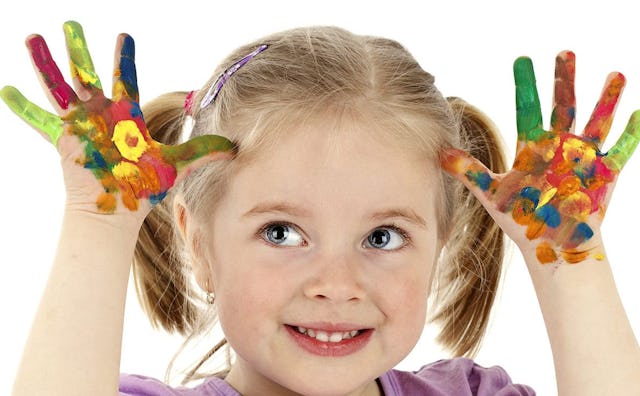My 6-Year-Old Daughter's Post-Impressionist Paintings

I’m looking at a drawing. It’s Scotch-taped to my daughter’s bedroom door, and for this one, Tate’s preferred medium is fruit-scented, colored markers. She’s 6. A rainbow crests into the shape of a wave, while a fat-trunked tree with clusters of bulbous leaves like pawpaws squats in its off-balance arches. The tree looks to be either struggling to use the rainbow as a harem girl might a brightly colored scarf, or about to get squashed by its tremendous girth.
This rainbow has gravity. It gives the impression of being solid and pliable like clay. For some reason, the color orange far outweighs any other: purple, blue, green, yellow, red. (Don’t mention indigo or violet. It only complicates things and gets Tate hot around the rhinestones.) Orange, though tapered at the ends, grows alarmingly wide toward the center, so instead of graceful curving pen strokes, its lines spray upwards like a mass of sunrays. Orange, it would appear, is making a statement. It’s fed up, tired of fitting so neatly into the color scheme of things. It’s busting out and threatening to take the rest of the rainbow with it, straight off the page. It shouts Let me out! and Where is that pot o’ gold anyway?!
This I refer to as Tate’s post-impressionist period. Like any evolving artist, she has phases. As a toddler experimenting with her first grip around a paintbrush, she embraced abstract expressionism. Tate was a minimalist. When her fingers grew strong enough to control a marker, her subjects became, not surprisingly, stick figures. But what makes these early works quintessentially Tates are their common characteristics: the majority are girls, all with disproportionately large heads, arm-length lashes, and hair that resembles long, curving air-filled balloons, confined to one side of their serene smiling faces and then stamped with a bow.
Kim McGinty
Eventually her girl subjects broadened to include members of the animal kingdom, in particular mice. I could create a coffee-table book with Tate’s pages upon pages of stick mice. Bodies round and arms in surrender, a hasty straight line for a mouth dividing their faces in two and subsequently leaving them all stuck in the same grim mood (the girl mice less so due to their long lashes and cheery bows). Macon, her 8-year-old brother, has become a seasoned critic.
“Tate!” He protests. “Boys have lashes too, y’know.”
Tate is unconcerned.
She branched out: two friends holding hands, always two; expressive families of hearts; mermaids that beckon with hands big as catcher’s mitts; cats peeking from tropical-toned houses where giant flowers float cloud-like in the sky. Punctuated by a startling and short-lived bunny phase. Not sweet-faced, fuzzy, winsome rabbits—Tate’s are clearly on the edge: bulgy eyes; high squared-off foreheads; thin, craning necks; ears at broken angles; and arms like those of a scarecrow. I can only assume her staunch aversion to carrots had some subconscious effect.
As every artist can’t help but be affected by some outside influences—for Tate, it’s first grade. Swimming in letters and words, she’s begun dabbling in what I call word-art. She begins by creating a crowded collage of sketches then proceeds to painstakingly label everything in her picture: cloud, bird, tree, bush, road, Eiffel Tower. The end result is a little like trying to follow a Roald Dahl road map.
Kim McGinty
I watch her at the kitchen table, blonde head bowed, licking her chapped lips in concentration, carefully choosing each fragrant color from a plastic tub that once held artichoke dip. She is as unselfconscious with her art as she is with herself. Vision unfiltered. No boxes, boundaries or societal barriers yet cluttering her way.
No doubt there will come a time when Tate will refrain from fashioning her skort into an over-the-shoulder tank-skirt because people just don’t wear their pants over their head. She’ll pause when her brother informs her putting blue eye shadow on her lips is weird and that flowers don’t come in those colors. She’ll learn to draw “normal” bunnies and decide, maybe one day soon, that donning a dress over a skirt over a pair of capris might be overkill. Forced, finally, to admit that indigo and violet do have their assigned place in a rainbow, survival of the artist may be slim. She will have to be dug up, retrieved from the rubble, born again with ears of the deaf and eyes of a poet.
Two springy white clouds sit atop Tate’s rainbow-wave, one big, one small. Once they were untouched—a perfect balance of color and the absence of color—but after living with it for a week, Tate decided smiley faces were in order (with lashes, of course, because these clouds are girls). Which goes to show, just as a true artist, Tate doesn’t always know when to stop. Bright blue pen strokes swoop around her happy clouds like a high wind, filling every inch of white space with sky, leaving nothing to the imagination and yet everything.
This article was originally published on